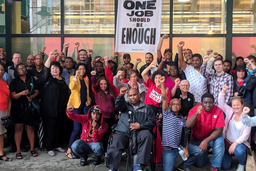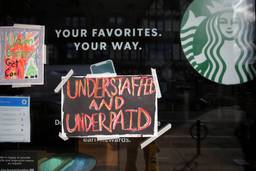
Members of one of the largest labor unions for post office workers are celebrating the success of a three-year campaign to roll back a commercial alliance between the U.S. Postal Service (USPS) and office supplies retailer Staples that threatened a major advance in the privatization of the national mail system. Coming just before the accession of Donald Trump to the White House, the victory marks one of the most successful corporate campaigns by any labor union during the Obama era.
The success also marks the rejuvenation of the American Postal Workers Union (APWU) under the leadership of Mark Dimondstein. First elected as president in 2013, Dimondstein promised union members a more aggressive attack on USPS privatization initiatives and a more progressive union overall. He delivered on those promises with the Staples campaign, and stood out in 2016 as one of the few union leaders to back insurgent Bernie Sanders’ campaign for the White House.
In an interview with In These Times, the union leader credits the success of the campaign to the thousands of hours of unpaid volunteer work by union members, and also to impressive demonstrations of solidarity by other unions, particularly teachers unions. Launched in 2014, the campaign gained early momentum, he says, and landed some of its most effective blows in mid-2014 and early 2015. Over the course of 2016, executives at USPS and Staples were in a slow retreat and formally caved in a letter to the union announcing the cancellation of the privatization effort earlier this month.
Union members were immediately galvanized in opposition when the USPS-Staples deal was announced as a “pilot program” in 2013. The pilot called for Staples to open “postal counters” in its existing retail stores where most standard post office services would be available. Such counters would be introduced in a number of select test markets, and gradually expanded to more than 1,000 Staples outlets nationwide. The workers at these counters would be non-union Staples employees, effectively replacing APWU members.
“It was obvious from the start that they were not being honest about the intentions of this program. If these Staples outlets were successful, then the next step would have been to close the regular post offices in those markets, and eliminate the union workers. It was a backdoor privatization. Our members are not stupid, and they saw it for what it was right from the beginning,” Dimondstein says.
The first order of business for the corporate campaign against USPS-Staples was to energize other unions, Diamondstein says, and this ultimately proved critical. Oher postal unions — notably the National Association of Letter Carriers and the National Postal Mail Handlers Union—were eager partners, he reports. Their call for a national boycott of Staples was endorsed by AFL-CIO in June 2014.
But the act of solidarity that carried the most powerful punch was the decision by the American Federation of Teachers (AFT) and the National Education Association (NEA) to support the boycott. According to Dimondstein, “There are 3 or 4 million teachers in this country, and in a lot of cities and towns the teachers are given the power to go out and buy school supplies. For Staples, these are customers who come back year after year. This is market power that has real meaning to corporations like Staples.”
AFT President Randi Weingarten even encouraged the APWU to stage a public demonstration against Staples at the same time as the AFT’s 2014 convention in Los Angeles. Weingarten personally led a large group of teachers from the convention to an APWU rally, held at the Staples Center sports arena, and delivered a fiery speech in support of the postal workers. She backed up the rhetoric, according to Dimondstein, with active efforts to get AFT affiliates to back the boycott nationwide.
“It was at that moment,” that the balance of power shifted in favor of the union, says Dimondstein. Other elements of the corporate campaign—public demonstrations, a legal attack at the National Labor Relations Board, nationwide publicity efforts, etc. — were beginning have an effect, but the teachers’ efforts seemed to pull it all together in the public mind, the union leader says.
Even so, it would take massive overreach by the corporate managers of Staples to drive a final stake through the heart of the USPS-Staples deal. In February 2015, Staples announced it would buy retail competitor Office Depot in a deal valued at $6.3 billion. But the combination of the two large office supply retailers raised obvious anti-trust issues. (A similar merger was blocked in 1997 by the Federal Trade Commission.)
The APWU jumped into action to oppose the merger, mobilizing other potential opponents and meeting with anti-trust regulators at the trade commission.
“Our research team did a just fantastic job. It’s hard for me to see how the merger could possibly have ever been approved after looking at their work,” Dimondstein says.
Sure enough, the trade commission ruled against the Staples-Office Depot deal, embarrassing Staples CEO Ronald Sargent and later costing him his job. The company was also forced to pay Office Depot about $250 million in a “break-up fee” for the failed merger, Dimondstein says.
“We opposed the merger and that put us squarely on the side of the consumer. As a union, we always want to be on the side of the consumer and that drives a lot what we do,” the APWU leader says.
Asked about the cost of the campaign, Dimondstein declines to answer directly. He insists, however, that the union spent less than $5 million and much of the cost was borne by unpaid volunteers from the membership.
“We were willing to spend whatever it took. But it doesn’t take as much as you’d think when you have a united membership willing to pitch in. We put in substantial resources, but our feeling [is] that this is precisely the kind of thing that union dues are for,” he says.
If the campaign presents a single overriding lesson, then it is the importance of labor union solidarity, Dimondstein concludes. Within USPS, there are multiple unions so “it is always divide and conquer with them.” But APWU was able to spearhead an effective coalition with other unions and also enlist the AFL-CIO in the boycott.
“The staying power of our own members is really what carried us and our allies forward,” Dimondstein says. “They had the confidence that workers can win — and will win.”

I hope you found this article important. Before you leave, I want to ask you to consider supporting our work with a donation. In These Times needs readers like you to help sustain our mission. We don’t depend on—or want—corporate advertising or deep-pocketed billionaires to fund our journalism. We’re supported by you, the reader, so we can focus on covering the issues that matter most to the progressive movement without fear or compromise.
Our work isn’t hidden behind a paywall because of people like you who support our journalism. We want to keep it that way. If you value the work we do and the movements we cover, please consider donating to In These Times.






